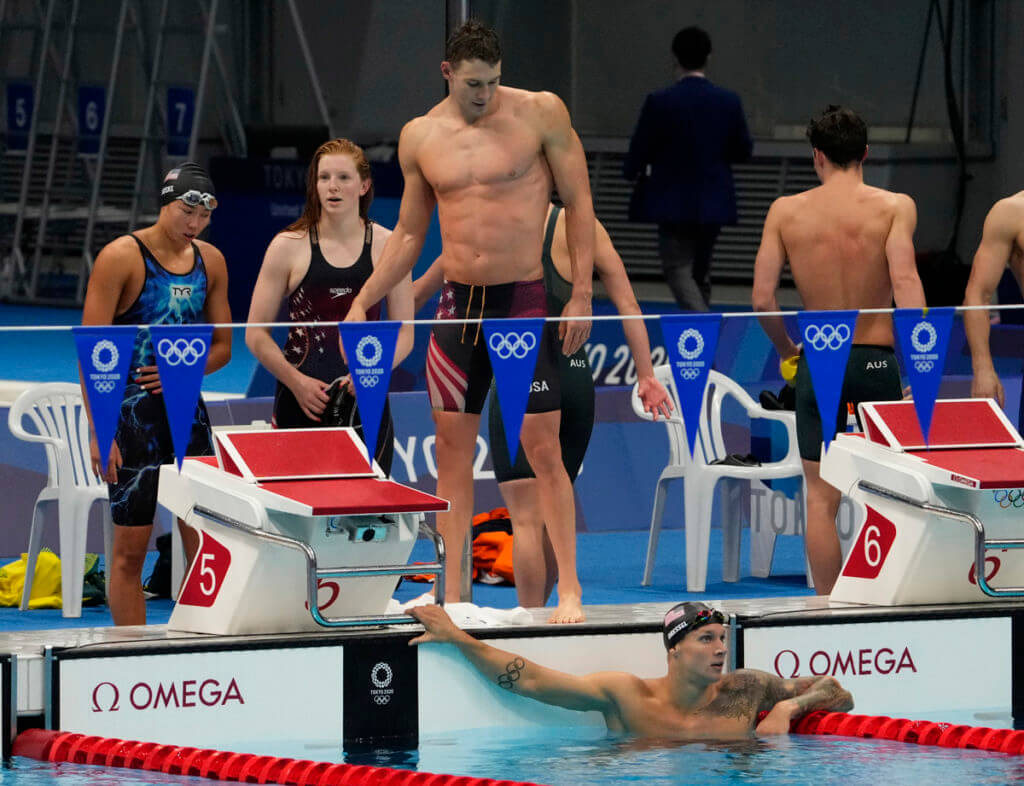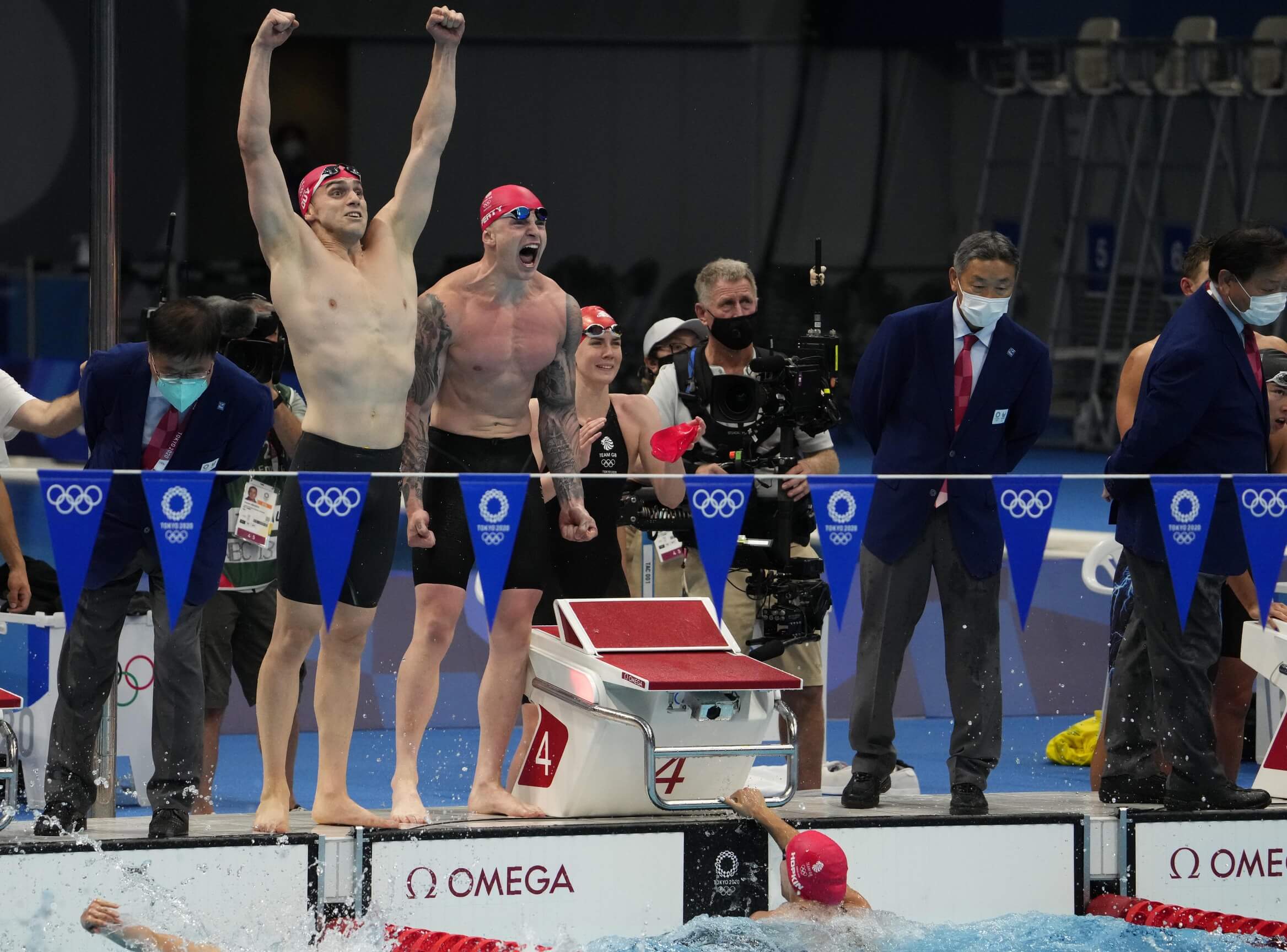‘We’re Learning Through This:’ U.S. Coaches Reflect on Mixed Medley Relay Flop

Editorial content for the 2021 Tokyo Olympic Games coverage is sponsored by GMX7.
See full event coverage. Follow GMX7 on Instagram at @GMX7training #gmx7

‘We’re Learning Through This:’ U.S. Coaches Reflect on Mixed Medley Relay Flop
There was a lot on the minds of Team USA coaches Greg Meehan and Dave Durden when they collected their staff to weigh options for the mixed medley relay.
The beauty of the new addition to the Olympic relay gauntlet lies in its machinations. It’s not straightforward like the men’s and women’s medleys – more or less, your “B” 100-stroke swimmers in prelims and “A” swimmers in finals. Instead, with two men and two women, it’s about maximizing gains and limiting losses.
So even before Lydia Jacoby’s goggles – and the team’s wheels – fell off, there was a lot of back-of-the-envelope math in play to vet the possibilities.
“We ran analytics, we had conversations about what we were feeling in our gut,” Meehan, the U.S. women’s head coach, said at a media availability after the final session of the Games Sunday. “We’re also evaluating that through the timeline of events, all of that stuff. We were disappointed we didn’t walk away with a medal, but certainly not from those four giving anything less than their very best. That’s on us as coaches to get better as we move forward the next time.”

The Great Britain mixed medley relay – from left, James Guy, Adam Peaty, Kathleen Dawson and (in the water) Anna Hopkin – got the race plan right on the way to gold and a world record; Photo Courtesy: Rob Schumacher-USA TODAY Sports
Ultimately, the watch said the U.S. made the wrong decision, the foursome of Ryan Murphy, Jacoby, Torri Huske and Caeleb Dressel finishing out of the medals in fifth, an exceedingly rare occurrence for the program that is the gold standard on relays.
There’s a certain amount left unsaid by Meehan and Durden, for coaching reasons. The prevailing logic is that you want to limit losses on the slowest stroke and capitalize on the comparatively smaller time difference on the fastest stroke. For seven of the eight finalists, that meant deploying a male breaststroker and a female freestyler, with the gender speed difference basically a wash on backstroke and butterfly.
The two main problems were personnel and scheduling. The only 100-meter stroke in which the men didn’t medal was breast (Michael Andrew was a distant fourth). On the women’s side, the U.S. didn’t medal in the 100 fly (Huske was fourth by .01) and 100 free (Abbey Weitzeil was eighth). That puts men’s breast and women’s free as the clear weaknesses relative to the field.
Complicating matters was that Andrew and Weitzeil had the semis of the 50 free just minutes before, which is a challenging double for the non-Dressel sector of humanity.
So already with tough choices for the format, the scheduled forced the coaches’ hand further.
“I think we looked at it different knowing the result,” Durden said. “We wouldn’t have done that. We would’ve said, ok let’s rethink this and make sure we’re using the right people.”
Generally, the swimmers selected did their jobs. Murphy tied Italy’s Thomas Ceccon for the fastest 100 back time in 52.23. Of four female butterfliers, Huske had the second-fastest split at 56.27, trailing only Zhang Yufei of China. Jacoby, who won the 100 breast in 1:04.95, turned in a respectable 1:05.09 given the goggle mishap and the fact that, as Weitzel said, they basically had to teach her how to do a relay pickup at camp in Hawaii.
But Jacoby’s time ceded more than eight seconds to otherworldly Adam Peaty’s 56.78 and the gold-winning Brits. That’s not on Jacoby as much as it’s a design flaw of the team architecture.
Durden said they didn’t look at what other teams were doing, and that bucking the early conventions wasn’t intentional so much as a product of their situation.
“For us, we looked at what we had available and what we felt as a coaching staff was going to generate the best performance for us, and that’s where we went,” he said. “I don’t necessarily know that we stepped back and said, other countries are doing it this way. … I don’t think at any point in that relay did we not have confidence in those four going out there and giving us a great performance, and we did. At the end of the day, it’s on us to step back and reevaluate how we do that, who we manage that, how we manage the swims over a nine-day meet, and just do a better job.”
The U.S. has gotten it right before. It won the mixed medley relay at the 2017 World Championships (in a then world record 3:38.56) with Lilly King swimming breaststroke and Simone Manuel anchoring, and took silver in 2019 with a similar lineup. They won silver in 2015 with Murphy and Kevin Cordes manning the front half; the top four finishers in that race sent the men out for the first two legs.
Time may prove that there is no singular right way to build a mixed medley relay. But the U.S. certainly hit on one of the wrong ways to do it in Tokyo.
“We’re learning through this,” Meehan said. “It’s still a relatively new thing.”





I think the relays should also use those swimmers with more experience on the big stage and who also have more relay experience.
Math is something you learn in grade school – a non-swimmer choosing the lineup just based on times could have gotten this right. The comments from the swimming community severely flamed the coaching staff even before the race took place. Was not their only bad call over the course of the meet costing medal places. Some reporters even trying to smear Jacoby over this. Thanks for not doing that.
Exactly! Sports Illustrated put out an article with the title blaming Lydia’s goggle malfunction for costing the US a medal. I appreciate that this article reports on the facts and that the coaches realize that the mistake was in the lineup.